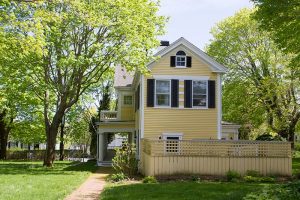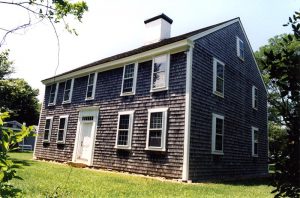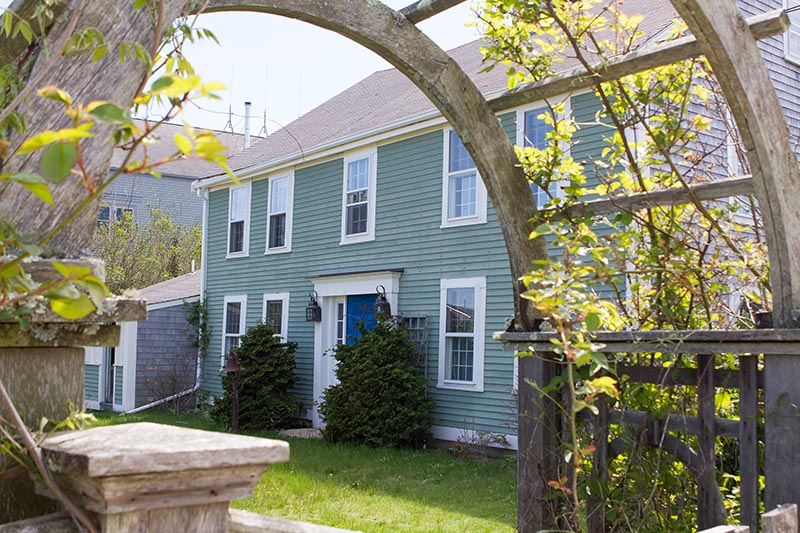Hundreds of historic houses dot the Island today, spanning nearly 350 years of its history, but many of them are tucked away on obscure dirt roads and private lands. These 12 are among those on full view: five available for tours (mostly in the summer months), and seven whose exteriors can easily be admired from public streets and sidewalks.
“Daggett Manor” (Union & Water Streets), a Colonial house that faces arriving ferry passengers across a gravel parking lot, is the oldest surviving residence in Vineyard Haven. It was built in 1717 by Captain Thomas Chase, who lived in it only years before he was lost at sea. His widow Jane turned it into a successful inn named “The Beehive,” and by 1800 it helped to make her grandson Isaac Daggett (who inherited the business) the richest man in town. With the death of Isaac’s widow, it became a private residence, which it remains today.

The Capt. Richard Luce House (40 William Street), a sprawling Greek Revival house clad in sunny yellow clapboards, stretches diagonally from William Street to Spring Street. It was built, in 1833, by a local whaling master with profits from a voyage so lucrative it made him a legend in his own time. The spacious porch on the east side (once the front, facing a long-vanished road) was inspired by Capt. Luce’s visits to Charleston, S.C.; the cupola allowed him to watch the comings and goings of his friends’ and neighbors’ ships.
The Benjamin Cromwell House (108 William Street) was also built with money made at sea, but Capt. Cromwell (who married one of Richard Luce’s daughters), made his fortune at the helm of the steamers Eagle’s Wing and Monohansett, ferrying tourists from New Bedford to Woods Hole and the islands in the second half of the 19th century. Its Gothic-revival style and elaborate wrought-iron fence make it a sharp contrast to the austere Colonial and Greek revival houses elsewhere along the street.
The Cottage Museum (2 Trinity Park) is typical of the tiny, two-story wooden structures that began to replace tents in the Methodist Campground around the time of the Civil War, with its centered double doors, front porch topped by a tiny balcony, and elaborate “gingerbread” trim. Its period furnishings reflect Campground life in the late 19th century, and a taste of the Vineyard’s first “tiny houses.” Open summers, Monday-Saturday, 10 am to 4 pm, and Sunday, 1 to 4 pm.
Dr. Harrison Tucker’s “Cottage” (61 Ocean Avenue), was built in 1872 with money made from making and selling patent medicine. Like many summer residences along Ocean Park, it applies the style of a Campground cottage to an opulent summer mansion; President Grant, on his 1874 visit to the Island, watched the fireworks staged in his honor from its porch. The Queen Anne-style Corbin-Norton house at 87 Ocean Ave., built in 1891 by lock manufacturer Phillip Corbin and restored by software magnate Peter Norton, is even grander.
The Dorothy West House (Myrtle Street), is typical of the modest homes in the Highlands neighborhood, where middle-class African American families from Boston and New York began to vacation in Oak Bluffs in the early twentieth century. West’s near neighbors included “Bunny Cottage,” owned by Rev. Adam Clayton Powell, Jr., and the Shearer Cottage guest house. All three are now stops on the Island’s African American Heritage Trail.
The Dr. Daniel Fisher House (99 Main St.) was built with whaling-industry profits, but its builder and namesake never went to sea. He made his (vast) fortune selling supplies to whalers and, in turn, buying and reselling the oil they brought home. His hardtack bakery, candle factory, and oil refinery were among the industrial buildings that lined Dock Street in the mid-nineteenth century. Owned by the Martha’s Vineyard Preservation Trust, which offers tours (weekdays only) from Memorial Day to Columbus Day at 11 am, and 12 pm, 1 pm, and 2 pm.
The Vincent House (behind the Fisher House), moved from its original site on the shores of Edgartown Great Pond, is one of the oldest houses on the Island. Built in 1672 and owned by the Vincent family until 1940, it is an early colonial “whole house” with two large first-floor rooms on either side of its massive central chimney. Parts of the entranceway may be even older, dating back to the 1640s. The Vincent House, along with the Whaling Church, is part of the Preservation Trust tour.

The Thomas Cooke House (Cooke & School Streets), is a classic two-story Colonial like “Daggett Manor” in Vineyard Haven, built in the 1740s and—according to tradition—used by as both a dwelling and a customs house. Unique among 18th-century homes in Edgartown, it was never fitted with electricity, plumbing, or central heat, making it a particularly clear window on life before the industrial era. Part of the Martha’s Vineyard Museum, it is open from June 19 to Oct. 9, Monday-Saturday 10 am to 5 pm, and Sunday, 12 to 5 pm.
Up-Island
The Captain William Lewis House (15 Music Street, West Tisbury) is a reminder that West Tisbury is tied to the sea, as well as the land. Capt. Lewis, a whaler and whaleship owner known as “the whale-bone king,” designed and built it in 1863 when he was still actively going to sea. Later owners, such as carriage-maker William Mayhew in the 1890s, added touches such as a the scrollwork around the porch: cut, like the “gingerbread” on Oak Bluffs cottages, with a power jigsaw.
The Allen Farmhouse (421 South Road, Chilmark) stands on land acquired by Jonathan Allen in 1762 and farmed by 12 successive generations of the family. The house — built by his son Tristram Allen in 1772, and meticulously restored by current owners Clarissa Allen and Mitchell Posin in 1998 — is flanked by antique outbuildings, traditionally constructed post-and-beam barns, and a century-old elm tree. The farm’s shop, offering wool, meat, and eggs, is open most days 11 am to 5 pm.
The Vanderhoop Homestead (Aquinnah Circle, Aquinnah) was built in the 1890s by Edwin DeVries Vanderhoop, a whaling captain and the first Wampanoag tribal member elected to the state legislature. Its expansive porch and distinctive shape — like two traditional Cape houses joined beneath a complex roofline — are a homegrown interpretation of the Victorian-style houses that circle Ocean Park. The interior, largely unaltered, houses the Aquinnah Cultural Center (open for tours Wednesday, Friday, Saturday, 11 am to 4 pm).




